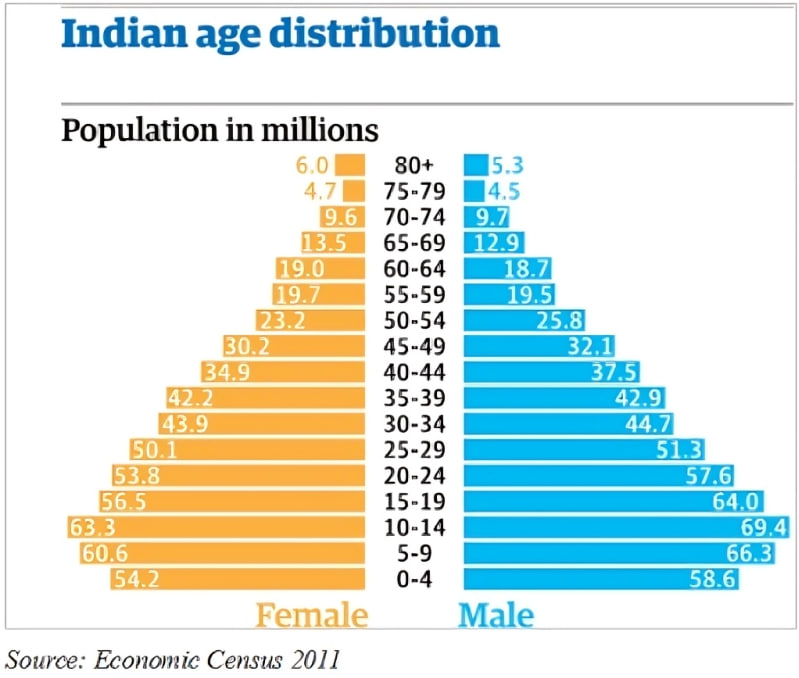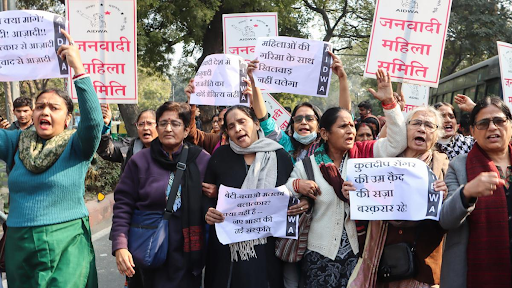Description

Copyright infringement not intended
Picture Courtesy: https://www.e-ir.info/2022/07/10/demographic-effects-on-fiscal-balances-in-india/
Context: The recently published article "Cashing in on India’s demographic dividend" by Richard Mahapatra highlights India's demographic scenario, particularly focusing on the challenges and opportunities associated with the demographic dividend.
Key Highlights of the Article
Understanding Demographic Dividend
- The demographic dividend occurs when the working-age population (15-64 years) exceeds the dependent population (below 15 years and above 64 years). This demographic structure can potentially lead to economic growth due to a larger workforce contributing to productivity and consumption.
- India is currently in the demographic dividend zone and is projected to remain so for another decade, with the peak expected around 2041 when the working-age population will constitute a significant portion of the total population.
|
Advantages of Demographic Dividend
●Increased labour force participation leads to higher productivity.
●Creation of fiscal space for investments in infrastructure and development.
●Rise in women's workforce participation due to declining fertility rates.
●Increase in savings rate, contributing to economic growth.
●Shift towards a middle-class society, fostering aspirational growth.
|

Opportunities and Challenges
- The demographic dividend presents an opportunity for India to leverage its large working-age population for economic development and growth.
- Despite the demographic advantage, India faces significant challenges in providing adequate employment and productive engagement for its youth.
|
Challenges Associated with Demographic Dividend
●The demographic dividend's benefits may be concentrated in specific regions, requiring equitable employment opportunities for realisation.
●Most new jobs will require high skills, posing a challenge due to the inadequacy of skilled labour in India.
●India's low rankings in human development indices highlight the need for substantial improvements in education and healthcare to enhance workforce efficiency.
●The informal nature of India's economy complicates efforts to fully utilise the demographic dividend.
●Future economic growth may not translate into sufficient job creation, leading to concerns about jobless growth and underemployment.
|
Youth Unemployment Statistics
- The article highlights the alarmingly high youth unemployment rate in India, with nearly 83% of the country’s total unemployed population being youth.
- Higher levels of education among youth correlate with higher unemployment rates, indicating a mismatch between education outcomes and labour market demands.
Skills and Education Gap
- There's a pressing need for massive skill development initiatives to bridge the gap between education and employability.
- Access to vocational training is limited, with only 4% of youth having access, exacerbating the unemployment problem.
Migration and Economic Impact
- Job scarcity in South Asia, particularly in India, has led to significant outflows of migrants seeking better employment opportunities abroad.
- The inability to create sufficient job opportunities for youth not only results in the loss of the demographic dividend but also poses broader economic stagnation risks and social unrest.
Policy Recommendations
- Human Capital Investment: Prioritise investments in healthcare, education, and skill development to enhance human capital.
- Skill Development: Establish initiatives like the National Skill Development Corporation (NSDC) to enhance employability through skill training.
- Job Creation: Policy interventions aimed at fostering job creation, particularly in labour-intensive sectors, are crucial to absorb the increasing youth labour force.
- Entrepreneurship: Encouraging entrepreneurship and innovation can create new avenues for employment and economic growth.
- Education Reform: Addressing the disconnect between education outcomes and market demands through education reform and vocational training programs.
- Healthcare Improvements: Enhance healthcare infrastructure to support a healthy and productive workforce.
- Urbanization Planning: Plan for rapid urbanisation by ensuring basic amenities and services for migrating populations.
Global Perspective
- Developed v/s Developing Countries: Developed countries have transitioned from the demographic dividend phase to an ageing population phase, relying increasingly on migrants for labour. In contrast, developing countries like India need to capitalise on their demographic advantage to achieve sustained economic growth.
Conclusion
- The article emphasises the critical need for India to effectively harness its demographic dividend through targeted policy interventions, job creation, and educational reforms. Failure to address the challenges associated with youth unemployment and skill gaps could lead to missed opportunities for economic growth and social stability. Addressing these issues is essential to ensure that India's large youth population becomes a driving force for inclusive and sustainable development in the years ahead.
Must Read Articles:
Jobs For Resilience Report
India’s Growth Trajectory
Source:
Down to Earth
|
PRACTICE QUESTION
Q. Automation and artificial intelligence are disrupting the job market. How can India ensure its growing workforce remains employable in the face of potential "jobless growth"? Discuss potential strategies to navigate the challenges posed by technological advancements while maximising the benefits of the demographic dividend.
|












